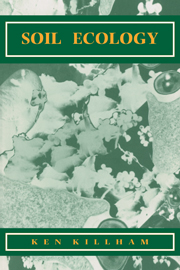Book contents
- Frontmatter
- Dedication
- Contents
- Foreword
- Introduction
- 1 The soil environment
- 2 The soil biota
- 3 Ecological interactions between the soil biota
- 4 The ecology of soil nutrient cycling
- 5 Ecology of extreme soil environments - soil water stress
- 6 Ecology of polluted soils
- 7 Manipulation of soil ecology - ‘soil biotechnology’
- References
- Further reading
- Index
- Frontmatter
- Dedication
- Contents
- Foreword
- Introduction
- 1 The soil environment
- 2 The soil biota
- 3 Ecological interactions between the soil biota
- 4 The ecology of soil nutrient cycling
- 5 Ecology of extreme soil environments - soil water stress
- 6 Ecology of polluted soils
- 7 Manipulation of soil ecology - ‘soil biotechnology’
- References
- Further reading
- Index
Summary
A great many books have been written on the soil ecology of microbes, of plants and, to a lesser extent, of animals. Integration of these themes, however, has largely remained unchallenged. This book has been written in an attempt to fulfil this challenge and to identify both the theory and applications of an integrated approach to soil ecology.
Never before has the need to understand the fundamental principles of soil ecology been so great. The urgency of feeding the world's growing population (partly through realising the potential benefits of modern biotechnology), of combatting soil pollution as well as responding to climate change has given soil ecological research vital importance.
Modern techniques, particularly involving molecular biology, are enabling study of soil ecology at a scale and with sensitivity never dreamed possible by the pioneers of the subject in the late eighteenth and early nineteenth centuries. This picture now emerging is one of immense heterogeneity with much of the soil's biological activity being restricted to niches or ‘hot spots’ such as the rhizosphere, fresh plant/animal residues, and the guts of decomposer organisms. The remaining bulk soil seems to be a zone of relative starvation or oligotrophy where activities and population densities are relatively low and may sometimes be maintained by novel growth strategies.
Since emerging from the primordial sea, a community has evolved to colonise the heterogeneous soil environment and penetrate all but the finest pores, adapted to life even under the most extreme conditions of water stress, temperature, acidity/alkalinity, aeration/redox and energy/nutrient supply.
Countless interactions of the components of the soil's biota have developed. Some of those involving plants and microbes, such as the mycorrhizal symbiosis, may have been necessary to create favourable nutrient/water relations to facilitate the transition from water to land. We are still discovering the complexity of soil biological interactions and this understanding will enable us to manipulate them for man's benefit.
The heterogeneity of soil in terms of soil particle and pore distribution causes a bewildering complexity of spatial compartmentalisation of soil organisms and the soil's other resources. Soil microbes in small pores and in sites of low pore connectivity, for example, may be well protected from protozoal attack but the advantages of this protection may be weighed up against the reduced substrate/nutrient supply associated with a pore microhabitat deep within a soil aggregate.
Information
- Type
- Chapter
- Information
- Soil Ecology , pp. xvii - xviiiPublisher: Cambridge University PressPrint publication year: 1994
